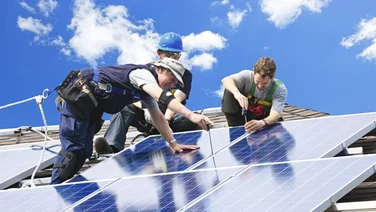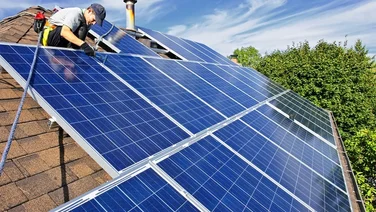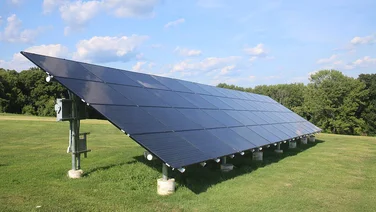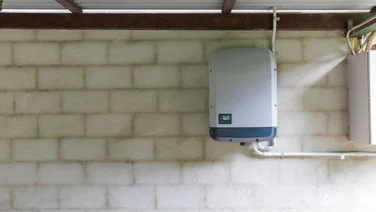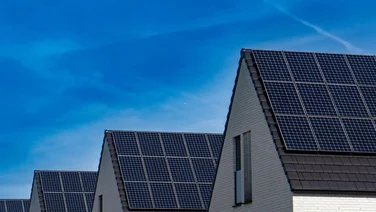- The world’s population currently consumes 23,900 terawatt-hours of power each year
- The carbon footprint of rooftop solar panels is roughly 12 times less than natural gas
- China currently produces around eight out of every 10 solar panels

The benefits of installing solar panels are clear. Solar panels can help reduce your monthly energy bills once installed, keep the lights on if there is any disruption in power and they can possibly increase the value of your home.
In fact, the average 350-watt (W) solar panel produces 2,645 kilowatt hours (kWh) per year in the UK, on average. That means that for every 1,000W of solar panels on your roof, you can expect to generate 756 watt-hours of electricity every year – although, this will largely depend on your location.
But how do solar panels work? Have you ever wondered about their carbon footprint? Most solar panels are created in factories in China or other areas of the world, mostly created by generating large quantities of electricity – and let’s not forget the carbon footprint they generate via travelling.
Like most technology, solar panels have some issues. But with most ‘new’ tech, they will improve over time. Despite these initial hiccups with solar panels, they do, in fact, pay for themselves in a relatively short period of time, both in terms of carbon reduction and embodied energy and electricity.
As the volume of solar panels manufactured increases, the carbon cost of their production will also continue to go down, further decreasing the carbon and energy ‘payback’ period – making them a strong investment for any homeowner.
Where do you want to install solar panels?
Get startedWhat is the environmental impact of solar panels?
Solar panels are not emissions free and will not solve all our environmental challenges on their own. They will, however, have a positive impact on your carbon footprint.
According to the International Plant Protection Convention (IPPC), the carbon footprint of rooftop solar panels is approximately 12 times less than natural gas and 20 times less than coal, in terms of CO2 emissions per kWh of electricity generated. However, rooftop solar has a larger carbon footprint than hydro, nuclear, and onshore wind turbines.
There are a handful of factors that affect the impact of solar panels on the environment, including:
- Mining of rare earth materials
- Use of hazardous materials in manufacture
- How far they need to be shipped
- How they are disposed of
- How they impact land use
The good news is there are many ways that the carbon footprint of solar panels is already being reduced, and their environmental impact is expected to continue decreasing steadily year on year.
What’s the environmental cost of producing solar panels?
There has been a long-standing debate that wind, solar and nuclear energy have hidden carbon footprint, pulling its environmental credentials into question.
This is misleading, however. Solar panels, of course, have to be manufactured, which naturally emits some carbons but the carbon cost is lower than the average emission of burning oil. In fact, solar panels emit 50g of CO2 per kWh in its first few years of operation.
Solar panels’ carbon neutrality comes from saving on carbon that would otherwise be emitted into the atmosphere, and they can become carbon neutral after three years of ownership.
After three years of use, solar panels’ overall carbon footprint drops into the negatives, since they’ll have saved more emissions from being released into the atmosphere than it takes to create them.
The environmental impact of producing solar panels
Most solar panels are made up of silicon semiconductors and glass, as well as a mixture of metals like silver, copper, indium, and tellurium.
When it comes to environmental impact, a lot of these materials are non-toxic and aren’t harmful to the environment. However, the process of mining for those metals creates greenhouse gas (GHG) emissions and can lead to soil, water, and air pollution.
It’s worth remembering, however, that solar panels and facilities are massive. It’s safe to assume that some wildlife and recreation land has been cleared to create solar panels in safe factories. However, the positives far outweigh the negatives.
The manufacturing process of solar panels
Solar panel manufacturing can be complicated. Solar panels use a lot of electricity when they are created, which is often generated using fossil fuels. Plus, its journey from factory to consumer all contribute to CO2 emissions.
However, as mentioned, solar panels will reverse their CO2 emissions within three years. What’s more, as more homes adopt solar panels, this will only increase. It’s predicted that installations will increase to over 450,000 per year by 2030.
There are ways to reduce a solar panel’s overall environmental impact during the manufacturing process. It all depends on where the panels are manufactured. For example, the share of electricity generated from coal in the UK in 2021 increased from 0.3% from 2020, to 2.1%. However, 63% of China’s electricity generation mix in 2021 came from coal.
While China currently produces around eight out of every 10 solar panels, other countries are beginning to manufacture their own. Solar panels are also manufactured in Vietnam, Malaysia, India, United States and South Korea.
Having to import solar panels means we’re emitting a large amount of CO2 before they even start operating. But as technology continues to evolve and countries begin to invest more into manufacturing plants, the CO2 emissions will only reduce each year.
Mining and hazardous materials
Each type of solar panel emits different amounts of CO2, but each uses silicon cells. These rare minerals are found across the world, but the largest deposits are found in Australia, Brazil, China and the US.
In a report by Engineerinc, these minerals can have a significant environmental cost. They can release harmful toxins into the air and water, and processing them requires large amounts of energy.
Companies are working to mitigate these effects, however, by using recycled materials and more efficient production processes. While there’s some way to go, this is a positive step in the right direction and the energy solar panels emit during the production stage will decline.
How solar panels are helping farmland
Some politicians have expressed concern over solar panels taking up valuable farming land. However, the truth is that solar farms and agriculture actually mix well together.
Solar farms are generally built on land that is not suitable for farming. But it is also possible to combine the two. For example, plants such as leafy greens or berries can benefit from the extra shade provided by the panels – which also reduces water use.
On grazing lands, solar arrays have been shown to increase the forage quality and reduce water demand.
This evidence is backed by the UK government, as well as renewable energy groups, such as Solar Energy UK, who have said that “solar farms pose no threat to the UK’s food security”.
“They also point to the multi-functional use of land, for example, grazing sheep on solar farms, to highlight that solar power and farming are not necessarily mutually exclusive,” the report said.
Going forward, Solar Energy UK claims many solar farm developers are now seeking to ‘co-locate’ grid-scale battery storage systems with their projects to existing solar farms. Ultimately, this will help extend battery life and create a better eco-system overall.
Types of solar panels
There are three types of solar panels – all of which use different materials, meaning the CO2e differ per panel. These three types are monocrystalline, polycrastalline and thin-film.
Monocrystalline panels are made by cutting a huge block of silicon into small wafers. This is a complex process and produces the highest emissions, compared to other solar panel manufacturing processes.
However, these panel types typically have an efficiency range of 15-20%, with some newer experimental models reaching close to 50%.
Polycrystalline solar panels are also made of silicon, but these crystals are melted together and then placed onto the panel. This still requires electricity, but not as much as monocrystalline panels.
Thin-film solar panels can be made from several different types of material, from amorphous silicon to copper indium gallium selenide.
Typically, thin-film solar panels leave a smaller carbon footprint compared to the other two types of solar panels, but are less used because they are created from extremely toxic materials and can cause environmental harm if not handled properly.
What is the impact of solar panel recycling?
In many areas of the world, commercial solar panels only started being rolled out in the late 1990s to early 2000s. We’re only now just starting to record the consequences solar panel waste has on the environment, due to its average life span of 25-30 years.
As a result, many manufacturers are looking for ways to reduce this impact as we receive more data. This includes recycling panels which have reached the end of its life span
Without proper recycling measures in place, it is estimated that 60 million tonnes of PV panel waste could accumulate in landfills by 2050. If left for landfill, some solar panel materials can seep into soil and groundwater, causing health and environmental issues – but there are ways around this.
Recycling solar panels
The good news is that solar panels can be recycled – but it’s not an easy process.
Firstly, homeowners should be aware that solar panels are considered to be electrical and electronic equipment (EEE), meaning they must be reported by the manufacturer as household, regardless of where they are installed. As noted by some organisations, solar panels also fall under the WEEE regulations.
But what does this mean exactly?
For homeowners, once your solar panels stop working, they need to be properly disposed of and sent for processing. But this doesn’t fall entirely on you.
Your installer is legally obliged to remove and recycle your old solar panels free of charge. All you need to do is get in touch with them to arrange a collection.
It’s likely you’ll need new solar panels installed, so this works out to be a more convenient option for you.
The number of materials that can be recycled does depend on the type. A typical crystalline silicon PV panel is made up of materials that can all be recycled. These include glass, polymer, aluminium, silicon, and copper. If we reuse these elements to create new products, we can decrease solar panel GHG emissions by 42%. The WEEE initiative has meant that European countries currently recycle most solar panels, despite China manufacturing the majority of solar panels, but they are only legally required to collect and recycle solar water. The US now has 23 solar panel recycling centres across the country.
In other areas, such as Australia, there are several solar panel recycling services. However, most facilities can only recycle 20% of the panels – the aluminium frame and the terminal boxes.
What are the environmental benefits of solar panels?
While we might still be early on in our journey to reducing emissions solar panels emit, solar energy is still one of the best tools we have to tackle climate change.
Fossil fuels are finite – and are rapidly depleting as we look for alternatives. Solar energy, on the other hand, is renewable and won’t run out any time soon – not for a few billion years, at least.
While the exact carbon footprint varies depending on the technology and location of manufacture, studies estimate that it ranges between 40 to 100g of CO2e per kilowatt-hour produced.
Where do you want to install solar panels?
Get startedHow is the industry improving?
As technology progresses, we’re seeing more innovation in the solar industry, with experts introducing more sustainable materials every year.
Most recently, scientists made a major breakthrough with a new type of solar panel that they claim could supercharge the transition to renewable energy sources. This breakthrough has been dubbed perovskite solar cells.
The Independent reported in September 2023 that perovskite is cheaper and lighter than conventional silicon-based cells, as well as far more efficient. It’s in its early stages, though, as perovskite solar cells currently suffer from a drop in efficiency.
In addition to this, researchers at the University of Bath recently created a different material: Kesterite. The material is formed from just copper, zinc, tin, and sulphur – all of which are quite low cost and abundant.
Solar panel recycling schemes are also becoming more popular worldwide – although, this needs to become more common for solar panel top dogs America, China, and Japan. The global solar panel recycling market size was recorded at $238.7m (£187.4 m) in 2022 and is projected to grow to $1.7bn (£1.3bn) by 2028.
Experts are also finding new ways to combine solar panels with biodiversity improvements – resulting in improvements in land use.
One improvement is to place solar panels on raised platforms or stilts to allow extra space underneath for the growth of perennial grasses and wildflowers to support local pollinators.
The latest research shows that sheep who live in fields with solar panels have healthier lives. They graze more, eat more nutritious food, rest more, and seem to suffer less from heat stress than sheep in nearby fields without panels.
This indicates that combining the panels with farming could improve both energy independence and farming output.
Next steps
Solar panels do have ‘hidden emissions’, but while these are a general cause for concern, solar panels still have a lower carbon footprint than many other types of energy.
And the good news is we’re certainly moving in the right direction to further reduce these emissions. More countries are putting new laws into place to make solar panel recycling mandatory, more farmers are looking for ways to host solar farms amid working farms and experts are continuing their search for more sustainable materials.
If you’re looking to install solar panels, we don’t blame you. With the average electric bill in the UK rising, energy bills have made 60% of people wanting to go greener, according to our 2023 National Home Energy survey.
You can find the best solar panels for your home through our free comparison tool. It will ask you a few simple questions about your property and our suppliers will help with the rest, starting with free quotes for you to compare and make the right choice for your home.


